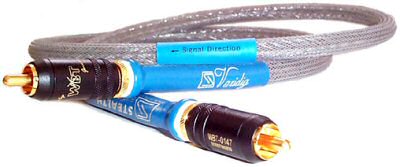 |

VARIDIG V16, V16-T and V16-T Select
digital interconnect
Varidig V16 is the new for
2016 revision* of the "original" Varidig.
The Varidig V16-T has a STEALTH tuning
collar**, the Varidig V16 (without the "T") doesn't have that
collar.
Except for the tuning collar, the
V16 and the V16-T are identical.
The Varidig V16-T Select is
special: It’s all about tolerances.
Even the best parts, the best wire and the best insulation –
everything has tolerances, numerous parameters vary to some
degree, being lower or greater than the optimum value. Such
variations exist in unterminated cables, the connectors used for
termination, and in completely assembled cables.
Our tolerances are established for ALL cables we make to work
well.
But SOME cables of a batch of ready cables measure better than
others. The simple and straight forward method would be to
separate them from the batch and set aside, and mark
"Select".
To increase the number of the best measured cables in each
batch, we developed a procedure.
For the Select version, we first hand pick the best parts:
connectors and wire.
Using selected parts, we prepare a bunch of cables – CANDIDATES
for the Select version, and measure them – prior to attaching
connectors.
The best measured cables – usually 2 to 5 out of ten made – are
hand picked for the Select version.
Then we attach connectors and measure the assembled cables, to
make sure the Select continue measuring best after having been
assembled.
Our measuring equipment is custom-made, and procedure and the
parameters we measure – are proprietary, and we prefer not to
reveal them. All I can say is that, among other parameters,
we measure the characteristic impedance of the cables, their
electrical damping (harmonics spectrum, at high frequencies), as
well as a number of lost packets transmitted in both
directions), and common-mode rejection (assessing quality of
symmetry and shielding).
Varidig V16 Select are shown
below:
Vardig V16 standard S/PDIF are shown below:
Vardig V16 standard AES/EBU are shown below:
Varidig (abbr. from VARIable DIGital) is our exclusive (patent pending) technology.
Varidig is different from any other digital cable on the market because its porous Teflon® dielectric is thicker in the middle of the cable than it is at the ends.
The picture below shows geometry of the inside wire assembly of
the AES/EBU Varidig, which explains the concept and the
technology: please
note as the wires become smaller in diameter as they approach
the end (the termination point); the twisting pitch also varies
along the cable - which is a great help in reducing cable'
internal resonances.
 |
This specialized dielectric geometry eliminates impedance mismatch at the critical points (where the connectors are attached to the cable, i.e. between the inherently low-impedance RCA connectors,
or still far from 110 Ohms XLRs, and the cable itself) which allows to achieve
the correct characteristic impedance of the ENTIRE cable, including
the connectors (75 Ohms for the S/PDIF version, and 110 Ohms
for the AES/EBU) and thus greatly reduce signal reflections in the cable. This Varidig
technology works equally well with S/PDIF and AES/EBU
configurations. Please see our Technical Notes for more details on the Varidig design.
TERMINATIONS
The Varidig V16 cables are available in S/PDIF (coax, 75 Ohms ) RCA-to-RCA, RCA to BNC, and BNC to
BNC configurations, and balanced AES/EBU (110 Ohms, XLR-to-XLR) configurations;
BNC to BNC Varidig can also be made in 50 Ohms configuration -
on a special request. Since the Varidig cables are made by hand
- i.e. NOT by a machine, we can make them in about ANY realistic
characteristic impedance - say, from 20 Ohms to well over 200
Ohms, but a need for such cables comes very seldom.
SOUND
Because of the advantages of its design, the Varidig allows
more digital information from the source to reach the
destination undistorted, and it's audible: subjectively, reduced
or eliminated reflections in a digital cable is perceived as
more silent background, cleaner overall sound and better "focus"
and "attack". In general, the more advanced and sophisticated
equipment is used, the better result can be achieved using the
Varidig cable.
STEALTH tuning collars
Based on numerous listening sessions with various equipment, a
STEALTH “T” cable with a tuning collar in the optimum
position, the overall result (sound) is better than with
the cable without the collar, BUT – with the collar in incorrect
position the sound is not as good as with a cable without the
collar.
The best sounding tuning collar position is different for every
two pieces of equipment which that cable connect, thus it is
impossible to point at the same spot (location) of the collar,
giving the same sound as without the collar.
Finding the best position of the collar is a lengthy process and
requires some time and patience. Usually two people are needed
(one is listening, and the other is moving the collar). It is
even better to have several people, and listen together.
So, usually, an evening, or even entire day can be dedicated to
finding the best collar position – for a particular audio
system.
But the result is worth the effort!
In general, finding the best position of the sliding tuning
collar on a STEALTH audio cable is similar in effect to finding
the best position (location) of a pair of speakers in a room: an
audio system sounds MUCH better if the position of the speakers
in optimized, and the same audio system doesn’t sound good with
wrong (incorrect) position of a pair of speakers in a room.
On the Varidig-T cable, start with the collar positioned some 8
inches from the SOURCE end, and slide in ˝ inch increments and
listen at every position. Usually, it takes about one hour to find the best
position. - ST
PRICING
Suggested retail prices:
|
Varidig Digital Interconnects |
0.6 m |
1 m |
1.5 m |
2 m |
Each add
meter |
|
Varidig V16-T Select S/PDIF
user tunable
patent-pending impedance matching design, STEALTH
Carbon/Teflon/silver
RCA or BNC |
$1,600 |
$1,800 |
$2,050 |
$2,300 |
$500 |
|
Varidig V16-T Select AES/EBU
user tunable
patent-pending impedance matching design, STEALTH
Carbon/Teflon/silver XLR |
n/a |
$2,400 |
$2,690 |
$2,980 |
$580 |
|
Varidig V16-T S/PDIF user tunable
patent-pending impedance matching design, standard
RCA or BNC |
$1,150 |
$1,250 |
$1,425 |
$1,600 |
$350 |
|
Varidig V16-T AES/EBU
user tunable
patent-pending impedance matching design, standard
XLR |
n/a |
$1,400 |
$1,640 |
$1,880 |
$480 |
|
Varidig V16 S/PDIF
- standard (NOT tunable)
patent-pending impedance matching design, standard
RCA or BNC |
$650 |
$850 |
$1,025 |
$1,200 |
$350 |
|
Varidig V16 AES/EBU - standard (NOT tunable)
patent-pending impedance matching design, standard
XLR |
n/a |
$1,000 |
$1,000 |
$1,200 |
$480 |
REVISION HISTORY*
The year 2000 through 2004 RCA Varidig cables were made with
gray outer jacket and were terminated with German-made WBT 0147 RCA connectors, which are the smallest and lowest in mass RCAs form the WBT line.

The RCA connectors used for current production Varidig are
Cardas GSMO (as shown on the photo): we found them to work
(slightly) better in the digital domain than the WBT because the
dielectric used in these Cardas connectors is TeflonŽ (which has
lower dielectric constant than the dielectric used in the WBT
0147 connectors);
In 2006, in order to improve the Varidig cable even further,
we developed our own locking connector for this cable, to offer
as an option. This
connector features hollow solid silver hollow center pin (crimp
termination technique), machined TeflonŽ dielectric, and a
hybrid (brass/carbon fiber) locking collar.
The standard XLR connectors used with the AES/EBU (balanced) Varidig are sourced from
Neutrik. Since August, 2006, we offer our own,
upgraded XLR connectors as an option: machined TeflonŽ dielectric and solid silver
hollow pins.
*We continuously improve our cables and connectors, and add improved and extra features to our products – as we design and test these improvements. The general sonic character of the
improved cable remains the same, it just becomes progressively better and better.
Eventually, with a number of improvements added, the cumulative effect of these improvements becomes significant – i.e. a cable works clearly, considerably better. At this point, we introduce a new revision to a cable model, which summarizes all improvements since the initial release of a particular model (or after the previous revision), making these improvements and features standard for the latest revision.
It’s worth noting that we keep our research and experimentation separate from production, i.e. All cable and connector changes are thoroughly tested before going into production. We never make changes just for the sake of making changes: All improvements that we introduce make perfect and clear sense from the engineering point of view, and are always tested sonically We make absolutely certain that these changes are an actual improvement (i.e. NOT a degradation in any area); we pride ourselves that – since 1999 up to date - no mistakes, errors, or wrong moves have been made or noted. Before adding any improvement, and especially releasing a new revision to any of our products, we always make absolutely certain that the latest revision is better than the previous in each and every respect – being it sonics, appearance, reliability or user convenience.
**
|
 |
|



